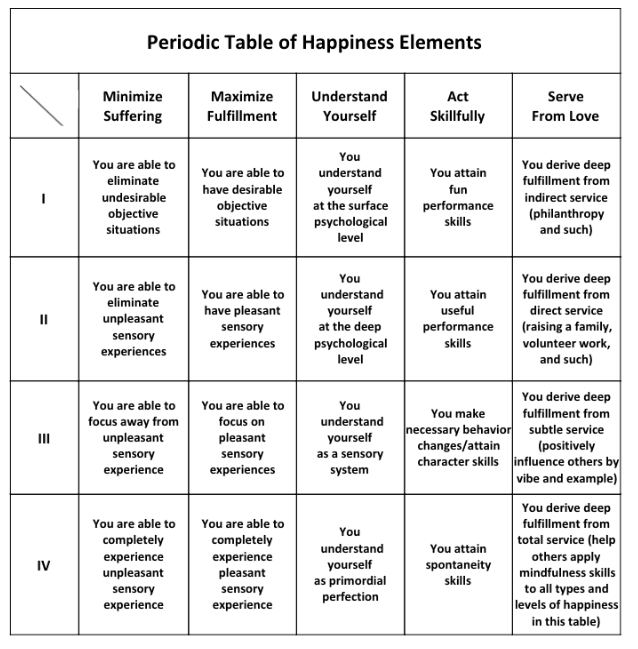This month I’m researching and teaching about how meditation and mindfulness training help with self-understanding.
Here’s what I know:
Most people view mindfulness training as stress reduction
Most people see meditation practice as separate from the rest of their lives
People want to understand why they do certain things, especially things that are self-sabotaging
Mindfulness training can help with all of the above
Shinzen Young’s Happiness Grid
One of my favourite resources is Shinzen Young’s Happiness Grid. Here it is:
Shinzen broke the common elements that makeup happiness into these five categories. This makes it easier for you to think about what you want mindfulness to help you to do because saying, “I want to feel better” is a wide goal.
Here is an example: Say you have started a new job and previously had the habit of oversharing in other jobs. This usually resulted in low-trust and being skipped over for promotions.
You could look at the Happiness Grid and say, “I would like to understand why I do this, eliminate the unpleasant sensory experience that causes that, and act more skillfully.”
In this case, you could do meditation practices that give you relief and self-understanding and help with performance skills. (As a coach, I build you customized mindfulness sets specifically designed to help with any goal).
Self-understanding
This month I’m sharing practices specifically for the self-understanding column.
Here’s a video on that: https://www.loom.com/share/8d410841169b4352871c46cf0cc12a64
If you’d like to learn this with me, become a paid subscriber, and you’ll get access to the live morning meditation sessions (and the recordings), plus weekly prompts to help you understand yourself better.
Linking the cushion with the rest of your life
The biggest gap in mindfulness training is integration. They are seen as two separate things. There is meditation time. There is the rest of life. But, to me, meditation is where you get to see your habits, self, and things beyond your senses; in short concentrated doses that give you insight into the rest of your life.
You can take these insights to help with everything else.
I’ll give you an example.
There is a technique I have shared here before (again free for paid subscribers) called See Hear Feel. This technique asks you to focus on what you can see, hear or feel. It is meant to build appreciation for what it is.
When I first learned this technique, I would be eager for about 5 minutes and then check out. I stopped labelling and doing the technique because it was hard and boring.
Instead of saying, “This technique sucks, and I suck as a meditator.” I noticed that I did this. I thought, “When things are boring, I give up.” That is an insight.
So, I looked at other areas of my life and noticed where I gave up when things got boring. It was a lot.
I returned to the practice and said, “When I notice I am bored, instead of zoning out, I’ll try to stick with the technique.”
I did. It was hard, but instead of giving up, I pushed through and noticed that it allowed me to access a deeper state of existence. I wasn’t just seeing regular things; I started to see the objects in my room expanding and contracting. That is cool.
I kept doing the technique, and because I had success on the cushion, it became easier to integrate this behaviour into my work. Instead of giving up on a short story because I was bored or stuck, I learned how to ride that edge of discomfort.
I have many stories about how working on the cushion helped me know and express myself better, but this first lesson set the tone for that growth to be possible.
If you get everything you need from your meditation practice, great. If you want to deepen your insights, try paying attention to what insights appear during practice that also appear in other areas of your life. It can change things for you.
And, if you’re looking for short (10 minutes) practices to support this growth, becoming a member (just $6 a month here) gets you access to practices and reflections to help.


